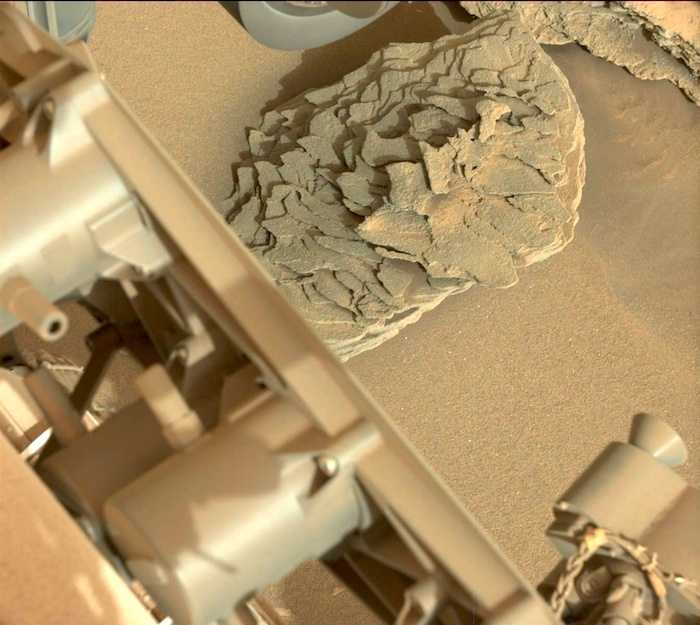23.10.2018

Foto: NASA
Martian groundwater could contain enough oxygen to support aerobic life, including simple animals such as sponges, scientists say.
Not that this means there is life on Mars. But it raises the possibility that if it does exist, it could be more complex than previously imagined.
“On Earth, oxygen has been a very powerful driver for evolution,” says Vlada Stamenković, a planetary scientist and physicist at NASA’s Jet Propulsion Laboratory in California, US.
Earth’s oxygen arose about 2.35 billion years ago in the “great oxidation event”, in which photosynthetic bacteria released large amounts of it into a previously oxygen poor-atmosphere.
“We also see more complex forms of life appearing around that time,” Stamenković says.
But oxygen is only 0.145% of the Martian atmosphere, compared to 21% on Earth — and the entire Martian atmosphere is only 0.6% as dense as Earth’s. On Mars, oxygen is a rare gas, indeed.
In a study published in the journal Nature Geoscience, however, a team led by Stamenković discovered that under temperature and pressure conditions known to occur near on the surface of Mars, startlingly large amounts of oxygen could wind up being dissolved in the planet’s groundwater — far more than needed to support aerobic life.
What’s required, Stamenković says, are brines — salt waters — which, his team found, can easily concentrate oxygen, even from the thin Martian atmosphere. The process works best, he adds, at colder temperatures such as those near the Martian poles, and in lowlands, where the air pressure can be three times denser than on the planet’s highest peaks.
This understanding, he says, will give scientists guidance in trying to figure out where to go to verify the theory, and possibly find signs of life, in future Mars missions.
Already, he says, his team is designing an instrument called Transmissive H2O Reconnaissance (TH2OR ), which would use low-frequency electromagnetic waves to probe beneath the surface in search of the type of briny groundwater in which oxygen could be concentrated. “So, those waters can show themselves without really touching them,” Stamenković notes.
Other researchers are working to develop ways to drill beneath the Martin surface to sample these groundwaters once they are located.
But don’t get too excited, too soon. “There are many other requirements for aerobic life besides oxygen,” says David Catling, a planetary scientist at the University of Washington, Seattle, US. These include a source of organic carbon, warm-enough temperatures, and water that’s not so salty it functions more as a preservative than a medium for life.
“Where would aerobic microbes on Mars get the organic carbon needed for respiration?” he asks.
And even though the salt in brines can dramatically lower water’s freezing point, life as we know it needs temperatures that aren’t absurdly cold. “Microbes on Earth stop reproducing below about minus 15 degrees Celsius,” Catling says.
Microbes also don’t do well in situations where there’s not enough available water, quantified in terms of water activity.
“We don’t need to put honey in the fridge, because microbes can’t get enough water from the honey, so the honey doesn’t spoil,” he explains. The same applies to extremely salty water — which is why our ancestors often used salt as a preservative.
Stamenković agrees that these are concerns, but doesn’t think they’re insurmountable. It’s possible, he says, that life could exist in warmer climes beneath the cold, oxygen-containing brines – using the brines, in essence, as refrigerators from which they could withdraw oxygen without actually having to live there.
He also notes that the cold-temperature limits on life on Earth are mainly due to the formation of ice crystals, something that won’t happen in the brines included in his study.
Whatever its ultimate impact on the search for life on Mars, the new study may have also answered one of the solar system’s most enduring questions, which is why the Red Planet is, well, red.
Scientists have long known its rusty colour comes from the presence of large quantities of iron oxides on it surface. The Curiosity rover has also found manganese oxide in Martian rocks, something that is hard to account for without the presence of substantial amounts of dissolved oxygen in the groundwater.
Trying to explain where that oxygen came from, in fact, was one of the inspirations for Stamenković’s study.
“Perhaps,” Catlin says, “brines with dissolved oxygen helped rust the surface of Mars and can explain what people have been seeing for millennia, ever since primitive humans turned their gaze to the night sky and noticed a red, wandering star.”
Quelle: COSMOS
